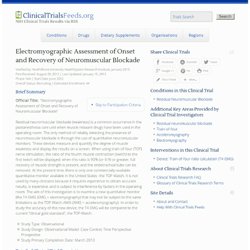

Electromyographic Assessment of Onset and Recovery of Neuromuscular Blockade: Residual… Brief Summary Skip to Participation Criteria Official Title: “Electromyographic Assessment of Onset and Recovery of Neuromuscular Blockade” Residual neuromuscular blockade (weakness) is a common occurrence in the postanesthesia care unit when muscle relaxant drugs have been used in the operating room.

The only method of reliably detecting the presence of neuromuscular blockade is through the use of quantitative neuromuscular monitors. These devices measure and quantify the degree of muscle weakness and display the results on a screen. The effect of maintaining a constant preload or a constant degree of thumb abduction in the isometric twitch force of the thumb. Method and apparatus for determining the level of neuromuscular block in a patient. This invention pertains generally to the field of instrumentation for determining the degree of neuromuscular block existing in an anesthesized patient.

Neuromuscular blocking drugs, or muscle relaxants, are widely used by anesthetists for producing muscle relaxation during anesthesia and surgery. Controlled muscle paralysis in the patient is commonly used for tracheal intubation, surgical relaxation and to permit controlled breathing in thoracic surgical procedures. Neuromuscular monitoring in clinical practice and research. A comparison of train-of-four monito... [Acta Anaesthesiol Scand. 1999. Method for monitoring anesthesia in patients in surgery with thumb. Intraoperative neuromuscular monitoring site ... [Anesthesiology. 2012.